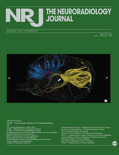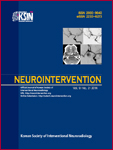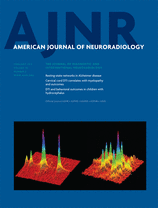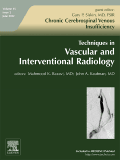
Neuroradiology Journal
Scope & Guideline
Connecting researchers to vital discoveries in neuroradiology.
Introduction
Aims and Scopes
- Diagnostic Imaging Techniques:
Focuses on the development and application of advanced imaging modalities such as MRI, CT, and PET for diagnosing neurological conditions including tumors, vascular malformations, and degenerative diseases. - Interventional Neuroradiology:
Covers innovative techniques and outcomes related to endovascular treatments for conditions like aneurysms, arteriovenous malformations, and acute stroke interventions. - Machine Learning and AI in Neuroimaging:
Explores the use of artificial intelligence and machine learning algorithms to enhance diagnostic accuracy, automate imaging analysis, and improve patient outcomes. - Clinical Outcomes and Predictive Modeling:
Investigates the correlation between imaging findings and clinical outcomes, including predictive modeling for treatment efficacy and patient prognosis. - Multidisciplinary Approaches:
Encourages collaboration across specialties, integrating insights from neurology, oncology, surgery, and pathology to improve diagnostic and therapeutic strategies. - Emerging Technologies:
Focuses on novel imaging techniques and technologies, including high-field MRI, advanced spectroscopy, and hybrid imaging methods.
Trending and Emerging
- Integration of AI and Machine Learning:
There is a growing emphasis on the application of artificial intelligence and machine learning in imaging analysis, with studies exploring automated detection, segmentation, and diagnostic prediction. - Advanced Imaging Techniques:
Research is increasingly focusing on cutting-edge imaging technologies such as ultra-high-field MRI, diffusion tensor imaging, and quantitative imaging techniques that enhance diagnostic capabilities. - Interventional Techniques and Outcomes:
A significant trend is the exploration of innovative interventional techniques, including flow diversion and advanced embolization strategies, with an emphasis on treatment outcomes and safety. - Neuroimaging in COVID-19:
The impact of COVID-19 on neurological health and the associated neuroimaging findings has become a prominent research area, with studies addressing the long-term effects of the virus on the brain. - Multimodal Imaging Approaches:
An increasing number of studies are adopting multimodal imaging strategies that combine various imaging modalities to provide comprehensive insights into complex neurological conditions. - Personalized Medicine in Neuroimaging:
Research is trending towards personalized approaches in neuroimaging, tailoring imaging protocols and treatment strategies based on individual patient profiles and genetic markers.
Declining or Waning
- Traditional Diagnostic Approaches:
There is a noticeable decrease in studies relying solely on conventional imaging techniques without integration of advanced methods or AI, as the field moves towards more sophisticated diagnostic tools. - Basic Case Reports:
The frequency of simple case reports has waned, with a shift towards more complex, multifactorial studies that provide broader insights and implications for clinical practice. - Generalized Vascular Imaging:
Research focusing on generalized vascular imaging without specific clinical applications or outcomes is becoming less common, as studies increasingly target specific conditions and patient populations. - Descriptive Studies:
There is a reduction in purely descriptive studies that do not incorporate advanced analysis or predictive modeling, as the emphasis moves towards studies that provide actionable insights and data-driven conclusions.
Similar Journals

Abdominal Radiology
Unveiling the Future of Abdominal ImagingAbdominal Radiology is an esteemed journal published by Springer, focusing on the intricate and evolving field of abdominal imaging. With its ISSN 2366-004X and E-ISSN 2366-0058, this journal serves as a vital platform for disseminating high-quality research and clinical findings that advance both the understanding and practice of radiology specifically related to abdominal diseases. With a commendable impact, categorized in 2023 as Q2 in the fields of Gastroenterology, Radiological and Ultrasound Technology, and Radiology, Nuclear Medicine and Imaging, and Q1 in Urology, it attracts an audience eager for cutting-edge insights. Furthermore, its ranking in Scopus reflects its strong influence, with a notable position of #21 in Urology and #92 in Radiology. The journal adopts an Open Access model, facilitating a wider dissemination of knowledge and promoting collaborative research efforts on a global scale. The convergence of contributions from established researchers and emerging professionals alike enriches its content from 2016 to 2024, ensuring that readers remain at the forefront of abdominal diagnostics and therapeutic advancements.

European Journal of Radiology Open
Connecting Researchers to the Future of Imaging ScienceThe European Journal of Radiology Open, published by Elsevier, has established itself as a pivotal platform for disseminating high-quality research in the field of radiology, nuclear medicine, and imaging since its inception in 2014. This open access journal, holding a commendable Q2 ranking in the esteemed 2023 Scopus categorization, seeks to foster a collaborative environment where researchers, professionals, and students can share innovative findings and advancements. Operating under the E-ISSN 2352-0477, this journal contributes to the broader scientific discourse with a commitment to accessibility and transparency, ensuring that cutting-edge research is available to a global audience. The journal's dual focus on rigorous peer review and rapid publication processes underscores its importance within the academic community, aiming to empower professionals with the latest insights in the dynamic landscape of medical imaging.

Neurointervention
Innovating Neurology and Radiology TogetherNeurointervention, published by the Korean Society of Interventional Neuroradiology (KSIN), is a distinguished Open Access journal that has been a pivotal resource in the fields of neurology and radiology since its inception in 2011. With an ISSN of 2093-9043 and E-ISSN 2233-6273, this journal serves as a vital platform for disseminating innovative research, clinical practices, and advancements in interventional neuroradiology. Situated in South Korea, Neurointervention enjoys a respectable standing in scholarly circles, currently categorized as Q3 in both Neurology (clinical) and Radiology, Nuclear Medicine and Imaging for 2023. It features rigorous peer-reviewed articles, aimed at fostering knowledge exchange and improving patient outcomes in these dynamic fields. As it converges research endeavors from 2019 to 2024, the journal is essential for researchers, clinicians, and students aspiring to stay at the forefront of neurointerventional techniques and methodologies.

AMERICAN JOURNAL OF NEURORADIOLOGY
Elevating Standards in Neurological Imaging and CareAMERICAN JOURNAL OF NEURORADIOLOGY, published by the American Society of Neuroradiology, is a premier peer-reviewed journal dedicated to advancing the field of neuroradiology. With an ISSN of 0195-6108 and an E-ISSN of 1936-959X, the journal serves as a vital resource for clinicians, researchers, and students in the realms of neurology and radiology. With a commendable Q1 ranking in multiple categories including Medicine (Miscellaneous), Clinical Neurology, and Radiology, Nuclear Medicine and Imaging, it remains at the forefront of scholarly communication since its inception in 1980. The journal enjoys significant visibility, ranked #47 out of 333 in radiology and #81 out of 400 in clinical neurology, highlighting its impact within these competitive fields. Although it is not open access, AMERICAN JOURNAL OF NEURORADIOLOGY is committed to publishing innovative research that enhances clinical practice and informs neurological imaging techniques, making it an essential read for anyone involved in the advanced study of neuroradiology.

Diagnostic and Interventional Imaging
Advancing the Frontiers of Imaging ExcellenceDiagnostic and Interventional Imaging, published by Elsevier Masson, stands as a prominent journal in the fields of Radiology, Nuclear Medicine, and Imaging. With a significant impact factor and a reputation for high-quality research, this journal is dedicated to advancing the understanding and application of diagnostic and interventional imaging techniques. It has achieved an impressive Q1 ranking across multiple categories including Medicine (miscellaneous) and Radiological and Ultrasound Technology, demonstrating its esteemed position within the academic community. The journal features cutting-edge studies and reviews, reflecting the latest innovations and practices from 2012 to 2024. Researchers, healthcare professionals, and students alike can look forward to accessing valuable insights that drive forward the discipline and improve patient outcomes, as evidenced by its robust Scopus rankings placing it among the top journals in its domain.

Techniques in Vascular and Interventional Radiology
Exploring the Frontiers of Interventional Radiology.Techniques in Vascular and Interventional Radiology, published by Elsevier, is a distinguished journal dedicated to the rapidly evolving field of vascular and interventional radiology. With an ISSN of 1089-2516 and an E-ISSN of 1557-9808, this journal serves as a critical platform for disseminating innovative research and practical advancements in the diagnosis and management of vascular diseases. Operating from the United States, it has established a significant presence in the academic community, evidenced by its 2023 Scopus rankings placing it in the Q3 quartile for both Cardiology and Cardiovascular Medicine and Radiology, Nuclear Medicine and Imaging. The journal aims to publish high-quality articles that encompass both clinical applications and novel technologies, making it an essential resource for researchers, clinicians, and students alike. With its commitment to fostering knowledge and collaboration in this vital area of medicine, Techniques in Vascular and Interventional Radiology plays a key role in advancing patient care and clinical practice.

Magnetic Resonance in Medical Sciences
Bridging Science and Medicine Through MRI InnovationsMagnetic Resonance in Medical Sciences is a leading open-access journal published by the Japanese Society of Magnetic Resonance Medicine, dedicated to advancing the field of medical imaging through high-quality research articles and reviews. With a strong focus on radiology, nuclear medicine, and imaging technologies, this journal serves as a crucial platform for the dissemination of innovative studies, as evidenced by its impressive Scopus ranking of #75 in its category and a commendable 77th percentile standing. Since its inception in 2002 and becoming open access in 2016, it has fostered a collaborative research environment, welcoming contributions from both seasoned experts and emerging scholars alike. The journal's commitment to enhancing diagnostic techniques and patient outcomes makes it an invaluable resource for researchers, healthcare professionals, and students passionate about the transformative potential of magnetic resonance imaging. Located in Tokyo, Japan, Magnetic Resonance in Medical Sciences continues to shape the future of medical imaging through rigorous scholarship and impactful research.

RADIOLOGY
Connecting researchers and practitioners in radiology.RADIOLOGY, published by the Radiological Society of North America (RSNA), stands as a premier journal in the fields of radiology, nuclear medicine, and imaging. Established in 1945, this esteemed journal has consistently provided groundbreaking research and insights, helping to shape advancements in diagnostic imaging and therapeutic interventions. With a commendable Q1 ranking in its category and a remarkable 99th percentile ranking in Scopus, RADIOLOGY continues to be a pivotal resource for clinicians, researchers, and students alike. Although not an Open Access journal, it offers a wealth of high-quality peer-reviewed articles that contribute significantly to the ongoing discourse in the medical community. With a strong focus on innovative techniques and the integration of new technologies, RADIOLOGY remains essential for professionals aiming to stay at the forefront of medical imaging practices.

Egyptian Journal of Radiology and Nuclear Medicine
Innovating Insights for Global HealthcareThe Egyptian Journal of Radiology and Nuclear Medicine, published by Springer, is a premier open access journal that has provided valuable insights and advancements in the fields of radiology and nuclear medicine since its initiation in 2010. With an E-ISSN of 2090-4762, this journal is dedicated to bridging the gap between research and clinical practice, allowing for the dissemination of high-quality research to a global audience. Situated in Germany, it enjoys a robust reputation in the academic community, evidenced by its categorization in the Q3 quartile for 2023, as well as its Scopus ranking, where it holds a position of #225 out of 333 in the domain of Radiology, Nuclear Medicine and Imaging, placing it in the 32nd percentile. The journal's open access model ensures that researchers, professionals, and students can freely access innovative studies, reviews, and case reports that discuss the latest methodologies, technological advancements, and clinical outcomes in radiology and nuclear medicine. As it looks toward its converged years spanning from 2010 to 2024, the Egyptian Journal of Radiology and Nuclear Medicine continues to be an essential resource for advancing knowledge and fostering ongoing collaboration in these critical fields.

Clinical Neuroradiology
Bridging Science and Clinical Application in Neuroimaging.Clinical Neuroradiology, published by SPRINGER HEIDELBERG, is a leading journal in the fields of neurology and radiology, focusing on the intersection of clinical practice and cutting-edge imaging technologies. With an impressive impact factor and categorized within Q2 in Neurology (clinical) and Q1 in Radiology, Nuclear Medicine and Imaging, this journal is positioned at the forefront of scientific discourse, facilitating high-quality research dissemination from its origins in 2000 through to 2024. Situated in Germany, Clinical Neuroradiology provides a platform for researchers, professionals, and students to explore the latest advancements and insights in neuroimaging, ensuring that its readership remains at the vanguard of clinical practice. While it does not offer open access, the journal remains committed to fostering a vibrant academic community dedicated to enhancing patient care through innovative neuroradiological techniques and findings.